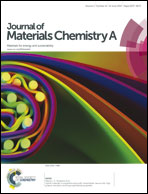The beneficial effect of protic ionic liquids on the lithium environment in electrolytes for battery applications
Abstract
This work reports the improved rate performance of ionic-liquid based lithium-ion batteries by replacement of the conventional aprotic ionic liquid (AIL) N-butyl-N-methylpyrrolidinium bis(trifluoromethanesulfonyl)imide (PYR14TFSI) by protic ionic liquids (PILs). Two model pyrrolidinium-TFSI PILs are synthesized and their mixtures with lithium bis(trifluoromethanesulfonyl)imide (LiTFSI) are characterized in terms of conductivity, viscosity and self-diffusion coefficients. Raman measurements show pronounced differences in terms of TFSI− coordination to Li+ between the AIL and the PILs. Li+ is coordinated by significantly fewer TFSI− anions in the investigated PILs, which is discussed as the likely cause for the much improved rate performance of lithium vanadium phosphate-based electrodes in these electrolytes.


 Please wait while we load your content...
Please wait while we load your content...